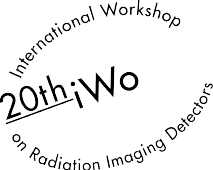Speaker
Description
Hybrid pixel detector modules are state of the art in vertex detectors of the high-energy physics as well as the x-ray cameras in synchrotron radiation experiments. Each module of such a detector consists of a sensor chip and one or more electronic readout chips. In order to connect every pixel on the sensor with an electronic readout cell both parts are bump bonded together. In comparison to the reflow soldering process with In or InSn thermo-compression bonding enables an even lower temperature to form the interconnection. Such a low temperature bonding process is required especially for high-Z sensor materials like Germanium, Cadmium-Telluride, Cadmium-Zinc-Telluride and MCT-sensors due to their limited temperature budget. The investigation presented here focus on a compression bonding process that will be applicable for such sensors. This low temperature compression bonding process is based on the use of a ductile bump material like indium and a dedicated UBM surface that is able to form intermetallic compounds with the bump metal.
A special test chip design was developed in order to investigate the influence of bonding parameters on the quality of the interconnection. The chip size of the test chip is adapted to the size of MEDIPIX3 readout chip with an identical number of bumps arranged in a 256 x 257 bump matrix with 55µm pitch in X- and Y-direction. When flip bonding this chip onto the sensor-test-chip, daisy chain test structures are formed on relevant positions of the resulting test module. In addition, four-point-kelvin-test structures have been designed to measure the electrical resistance of individual bumps. Other test features deal with the investigation of bonding pressure related to the risk to create shorts between adjacent bumps.
In order to achieve comparable results between daisy chain test chips and functional MEDIPIX readout chips and sensor chips a similar bonding metal layer stack was chosen [1]. Indium bumps were deposited by electroplating on the readout-test-chip side. Two different types of sensor-test-chips were designed. One pad defined type has a NiAu pad layer stack on top of a passivation layer. A second type of sensor-test-chip was designed with a passivation opening defined bonding area which means an Au-finished metal pad circumferential covered by a SiO2-passivation.
The investigation of the bonding process includes the variation of the bonding pressure, the bonding temperature and the dwell time of bonding pressure. A good quality of the bonding process was defined by a minimum value of the interconnection resistance and a closed daisy chain of bump interconnects. After electrical characterization pull tests were performed to investigate the corresponding bonding area. Good bonding results were achieved at temperatures of 80°C and 100°C. A minimum bonding pressure of 3.2 MPa is necessary to get a reliable bonding result. Daisy chain failures occur especially in the corner of the chips. Comparing the two different UBM pad structures we found a narrow distribution with less variation of all resistance values for the NiAu pads on top of the passivation layer. Pull test results show a larger bonding area for this UBM pad in comparison to the passivation opening defined bonding pad.
This project was performed in cooperation with the Photon Science Detector group of DESY, Hamburg. The author would like to thank Prof. Dr. Heinz Graafsma and his group for their support.
[1] F. Broennimann and et. al.: Development of an indium bump bond process for silicon pixel detectors at psi. Nuclear Instruments and Methods in Physics Research Section A: Accelerators, Spectrometers, Detectors and Associated Equipment, 565(1):303–308, 2006.




